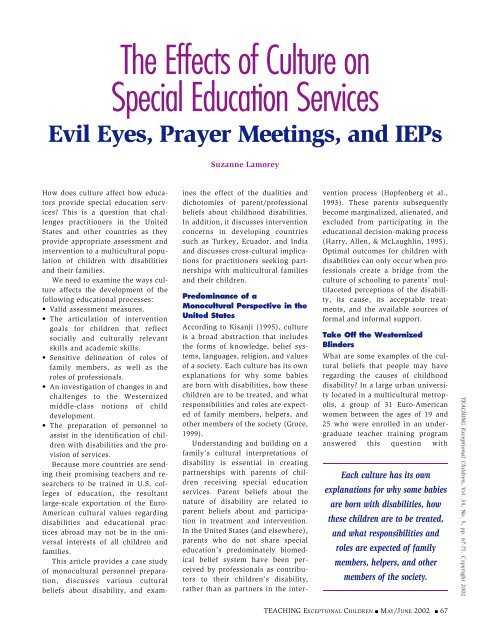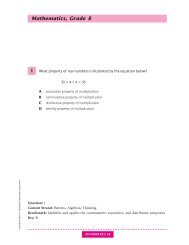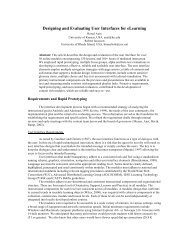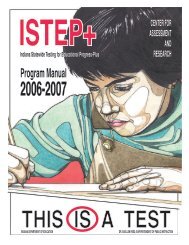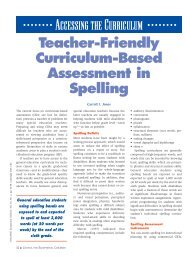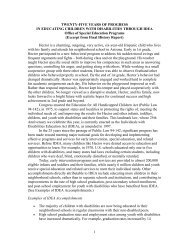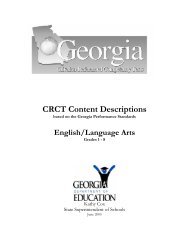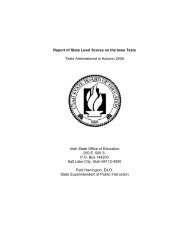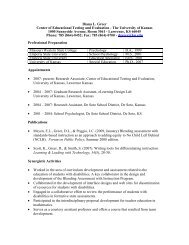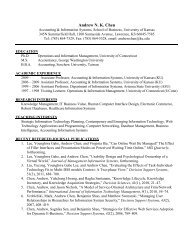The effects of culture on special education services: Evil eyes ...
The effects of culture on special education services: Evil eyes ...
The effects of culture on special education services: Evil eyes ...
You also want an ePaper? Increase the reach of your titles
YUMPU automatically turns print PDFs into web optimized ePapers that Google loves.
<str<strong>on</strong>g>The</str<strong>on</strong>g> Effects <str<strong>on</strong>g>of</str<strong>on</strong>g> Culture <strong>on</strong>Special Educati<strong>on</strong> Services<strong>Evil</strong> Eyes, Prayer Meetings, and IEPsSuzanne LamoreyHow does <str<strong>on</strong>g>culture</str<strong>on</strong>g> affect how educatorsprovide <strong>special</strong> educati<strong>on</strong> <strong>services</strong>?This is a questi<strong>on</strong> that challengespractiti<strong>on</strong>ers in the UnitedStates and other countries as theyprovide appropriate assessment andinterventi<strong>on</strong> to a multicultural populati<strong>on</strong><str<strong>on</strong>g>of</str<strong>on</strong>g> children with disabilitiesand their families.We need to examine the ways <str<strong>on</strong>g>culture</str<strong>on</strong>g>affects the development <str<strong>on</strong>g>of</str<strong>on</strong>g> thefollowing educati<strong>on</strong>al processes:• Valid assessment measures.• <str<strong>on</strong>g>The</str<strong>on</strong>g> articulati<strong>on</strong> <str<strong>on</strong>g>of</str<strong>on</strong>g> interventi<strong>on</strong>goals for children that reflectsocially and culturally relevantskills and academic skills.• Sensitive delineati<strong>on</strong> <str<strong>on</strong>g>of</str<strong>on</strong>g> roles <str<strong>on</strong>g>of</str<strong>on</strong>g>family members, as well as theroles <str<strong>on</strong>g>of</str<strong>on</strong>g> pr<str<strong>on</strong>g>of</str<strong>on</strong>g>essi<strong>on</strong>als.• An investigati<strong>on</strong> <str<strong>on</strong>g>of</str<strong>on</strong>g> changes in andchallenges to the Westernizedmiddle-class noti<strong>on</strong>s <str<strong>on</strong>g>of</str<strong>on</strong>g> childdevelopment.• <str<strong>on</strong>g>The</str<strong>on</strong>g> preparati<strong>on</strong> <str<strong>on</strong>g>of</str<strong>on</strong>g> pers<strong>on</strong>nel toassist in the identificati<strong>on</strong> <str<strong>on</strong>g>of</str<strong>on</strong>g> childrenwith disabilities and the provisi<strong>on</strong><str<strong>on</strong>g>of</str<strong>on</strong>g> <strong>services</strong>.Because more countries are sendingtheir promising teachers and researchersto be trained in U.S. colleges<str<strong>on</strong>g>of</str<strong>on</strong>g> educati<strong>on</strong>, the resultantlarge-scale exportati<strong>on</strong> <str<strong>on</strong>g>of</str<strong>on</strong>g> the Euro-American cultural values regardingdisabilities and educati<strong>on</strong>al practicesabroad may not be in the universalinterests <str<strong>on</strong>g>of</str<strong>on</strong>g> all children andfamilies.This article provides a case study<str<strong>on</strong>g>of</str<strong>on</strong>g> m<strong>on</strong>ocultural pers<strong>on</strong>nel preparati<strong>on</strong>,discusses various culturalbeliefs about disability, and examinesthe effect <str<strong>on</strong>g>of</str<strong>on</strong>g> the dualities anddichotomies <str<strong>on</strong>g>of</str<strong>on</strong>g> parent/pr<str<strong>on</strong>g>of</str<strong>on</strong>g>essi<strong>on</strong>albeliefs about childhood disabilities.In additi<strong>on</strong>, it discusses interventi<strong>on</strong>c<strong>on</strong>cerns in developing countriessuch as Turkey, Ecuador, and Indiaand discusses cross-cultural implicati<strong>on</strong>sfor practiti<strong>on</strong>ers seeking partnershipswith multicultural familiesand their children.Predominance <str<strong>on</strong>g>of</str<strong>on</strong>g> aM<strong>on</strong>ocultural Perspective in theUnited StatesAccording to Kisanji (1995), <str<strong>on</strong>g>culture</str<strong>on</strong>g>is a broad abstracti<strong>on</strong> that includesthe forms <str<strong>on</strong>g>of</str<strong>on</strong>g> knowledge, belief systems,languages, religi<strong>on</strong>, and values<str<strong>on</strong>g>of</str<strong>on</strong>g> a society. Each <str<strong>on</strong>g>culture</str<strong>on</strong>g> has its ownexplanati<strong>on</strong>s for why some babiesare born with disabilities, how thesechildren are to be treated, and whatresp<strong>on</strong>sibilities and roles are expected<str<strong>on</strong>g>of</str<strong>on</strong>g> family members, helpers, andother members <str<strong>on</strong>g>of</str<strong>on</strong>g> the society (Groce,1999).Understanding and building <strong>on</strong> afamily’s cultural interpretati<strong>on</strong>s <str<strong>on</strong>g>of</str<strong>on</strong>g>disability is essential in creatingpartnerships with parents <str<strong>on</strong>g>of</str<strong>on</strong>g> childrenreceiving <strong>special</strong> educati<strong>on</strong><strong>services</strong>. Parent beliefs about thenature <str<strong>on</strong>g>of</str<strong>on</strong>g> disability are related toparent beliefs about and participati<strong>on</strong>in treatment and interventi<strong>on</strong>.In the United States (and elsewhere),parents who do not share <strong>special</strong>educati<strong>on</strong>’s predominately biomedicalbelief system have been perceivedby pr<str<strong>on</strong>g>of</str<strong>on</strong>g>essi<strong>on</strong>als as c<strong>on</strong>tributorsto their children’s disability,rather than as partners in the interventi<strong>on</strong>process (Hopfenberg et al.,1993). <str<strong>on</strong>g>The</str<strong>on</strong>g>se parents subsequentlybecome marginalized, alienated, andexcluded from participating in theeducati<strong>on</strong>al decisi<strong>on</strong>-making process(Harry, Allen, & McLaughlin, 1995).Optimal outcomes for children withdisabilities can <strong>on</strong>ly occur when pr<str<strong>on</strong>g>of</str<strong>on</strong>g>essi<strong>on</strong>alscreate a bridge from the<str<strong>on</strong>g>culture</str<strong>on</strong>g> <str<strong>on</strong>g>of</str<strong>on</strong>g> schooling to parents’ multifacetedpercepti<strong>on</strong>s <str<strong>on</strong>g>of</str<strong>on</strong>g> the disability,its cause, its acceptable treatments,and the available sources <str<strong>on</strong>g>of</str<strong>on</strong>g>formal and informal support.Take Off the WesternizedBlindersWhat are some examples <str<strong>on</strong>g>of</str<strong>on</strong>g> the culturalbeliefs that people may haveregarding the causes <str<strong>on</strong>g>of</str<strong>on</strong>g> childhooddisability? In a large urban universitylocated in a multicultural metropolis,a group <str<strong>on</strong>g>of</str<strong>on</strong>g> 31 Euro-Americanwomen between the ages <str<strong>on</strong>g>of</str<strong>on</strong>g> 19 and25 who were enrolled in an undergraduateteacher training programanswered this questi<strong>on</strong> withEach <str<strong>on</strong>g>culture</str<strong>on</strong>g> has its ownexplanati<strong>on</strong>s for why some babiesare born with disabilities, howthese children are to be treated,and what resp<strong>on</strong>sibilities androles are expected <str<strong>on</strong>g>of</str<strong>on</strong>g> familymembers, helpers, and othermembers <str<strong>on</strong>g>of</str<strong>on</strong>g> the society.TEACHING EXCEPTIONAL CHILDREN ■ MAY/JUNE 2002 ■ 67
esp<strong>on</strong>ses that uniformly reflected aWesternized biomedical orientati<strong>on</strong>.Even when specifically urged torelate a family story or folk taleabout causes <str<strong>on</strong>g>of</str<strong>on</strong>g> disabilities, theseteachers-to-be did not (could not?)c<strong>on</strong>tribute any n<strong>on</strong>medical resp<strong>on</strong>sesother than “disability may beGod’s will.” On the other hand, agroup <str<strong>on</strong>g>of</str<strong>on</strong>g> 17 internati<strong>on</strong>al graduatestudents in educati<strong>on</strong>, representing avariety <str<strong>on</strong>g>of</str<strong>on</strong>g> cultural backgrounds,answered this questi<strong>on</strong> with a richcollecti<strong>on</strong> <str<strong>on</strong>g>of</str<strong>on</strong>g> beliefs about disability.<str<strong>on</strong>g>The</str<strong>on</strong>g>ir resp<strong>on</strong>ses included beliefs thatreflect the role <str<strong>on</strong>g>of</str<strong>on</strong>g> supernatural orcosmic causes, fate, magic, and religiousbeliefs, as well as biomedicalreas<strong>on</strong>ing (see box, “CulturalBeliefs”).In light <str<strong>on</strong>g>of</str<strong>on</strong>g> the implicati<strong>on</strong>s <str<strong>on</strong>g>of</str<strong>on</strong>g> them<strong>on</strong>ocultural orientati<strong>on</strong> <str<strong>on</strong>g>of</str<strong>on</strong>g> the U.S.students, the lack <str<strong>on</strong>g>of</str<strong>on</strong>g> awareness <str<strong>on</strong>g>of</str<strong>on</strong>g>other percepti<strong>on</strong>s and the shortcomingsin multicultural training experiences,as dem<strong>on</strong>strated by theresp<strong>on</strong>ses <str<strong>on</strong>g>of</str<strong>on</strong>g> these undergraduates,is discouraging. As Garcia, Mendez-Perez, and Ortiz (2000) wrote,“Differences in percepti<strong>on</strong>s are notproblematic. . . . <str<strong>on</strong>g>The</str<strong>on</strong>g> problem is createdwhen the possibility <str<strong>on</strong>g>of</str<strong>on</strong>g> such differencesis not even c<strong>on</strong>sidered, orwhen unquesti<strong>on</strong>ed assumpti<strong>on</strong>screate misunderstandings” (p. 97).Although there exist pr<str<strong>on</strong>g>of</str<strong>on</strong>g>essi<strong>on</strong>alstandards for the development <str<strong>on</strong>g>of</str<strong>on</strong>g> culturallyresp<strong>on</strong>sive <strong>special</strong> educati<strong>on</strong>programs, there are still far too manyU.S. educators—and people fromCultural Beliefs About the Causes <str<strong>on</strong>g>of</str<strong>on</strong>g> Childhood Disability• If mom cuts her hair during her pregnancy, it will cause a miscarriageor shorten the life <str<strong>on</strong>g>of</str<strong>on</strong>g> her baby.• If mom views a pers<strong>on</strong> with deformities during pregnancy, she willgive birth to a similarly deformed baby.• Having sex during pregnancy produces a child with disabilities.• Eating a grape or fish during pregnancy will produce a birthmark inthe shape <str<strong>on</strong>g>of</str<strong>on</strong>g> grapes or fish.• If mom eats fish during her pregnancy, her child’s skin will be scaly.• If mom eats spleen during pregnancy, it causes a dark birthmark <strong>on</strong>her baby.• If mom eats spleen and touches a part <str<strong>on</strong>g>of</str<strong>on</strong>g> her body then her baby willhave a dark birthmark <strong>on</strong> that area.• If mom smells certain foods during her pregnancy, she must lick herright hand to prevent the food from causing childhood disability.• If mom kills a lizard during her pregnancy, the baby will have visualdisorders.• God causes disabilities in order to examine a couple’s patience.• To ward <str<strong>on</strong>g>of</str<strong>on</strong>g>f the evil eye, a parent must spread black coal <strong>on</strong> the newborn’sforehead.• A new mother should keep a copy <str<strong>on</strong>g>of</str<strong>on</strong>g> the Koran and a broom close tothe newborn to avoid red genies that would disturb the mother andbaby.• No meat should be brought into the home <str<strong>on</strong>g>of</str<strong>on</strong>g> a newborn for 40 days toavoid newborn disability.• No women who are menstruating can visit a newborn baby or the babywill become ill.• <str<strong>on</strong>g>The</str<strong>on</strong>g> newborn should wear a red ribb<strong>on</strong> to protect it from harm.• During pregnancy, mom must avoid greasy foods as the grease collectsin the unborn child’s brain.• Messages about the baby and the baby’s health come to mom indreams during pregnancy.• If mom lies face down to sleep, baby will be deformed.Many families reported a release<str<strong>on</strong>g>of</str<strong>on</strong>g> some <str<strong>on</strong>g>of</str<strong>on</strong>g> their anxieties, fears,and guilt feelings by combiningcultural cures with Westerntreatment.other countries trained in the UnitedStates—who wear Westernizedblinders, unaware <str<strong>on</strong>g>of</str<strong>on</strong>g> the rich relati<strong>on</strong>shipsam<strong>on</strong>g beliefs, values,buffers, supports, roles <str<strong>on</strong>g>of</str<strong>on</strong>g> familymembers, and child outcomes inn<strong>on</strong>-Western c<strong>on</strong>texts.Multicultural Investigati<strong>on</strong>s <str<strong>on</strong>g>of</str<strong>on</strong>g>Parent Percepti<strong>on</strong>s <str<strong>on</strong>g>of</str<strong>on</strong>g> DisabilitySeveral studies have examined thepercepti<strong>on</strong>s and beliefs that parentsuse to understand the causes andmeanings <str<strong>on</strong>g>of</str<strong>on</strong>g> their children’s disabilities.• Cho, Singer, and Brenner (2000)compared the experiences andpercepti<strong>on</strong>s <str<strong>on</strong>g>of</str<strong>on</strong>g> Koreans and KoreanAmericans who were parentingchildren with developmental disabilities.Eighty percent <str<strong>on</strong>g>of</str<strong>on</strong>g> theKorean parents attributed causes<str<strong>on</strong>g>of</str<strong>on</strong>g> disabilities to their own mistakesrelative to prenatal enrichmentpractices and parenting attitudes(poor “Tae Gyo” whichtranslates to “educati<strong>on</strong> duringpregnancy”) while 63% <str<strong>on</strong>g>of</str<strong>on</strong>g> KoreanAmerican parents attributed thecauses to a divine plan (God’s willfor the family and child) as well aspoor “Tae Gyo.”• From Australia, Gray (1995)reported that 25% <str<strong>on</strong>g>of</str<strong>on</strong>g> the parents <str<strong>on</strong>g>of</str<strong>on</strong>g>children with autism menti<strong>on</strong>edreligious, magical, or psychologicalreas<strong>on</strong>s for the cause <str<strong>on</strong>g>of</str<strong>on</strong>g> theirchild’s disability.• Am<strong>on</strong>g Chinese-American parents<str<strong>on</strong>g>of</str<strong>on</strong>g> young children with disabilitiesin a study by Ryan and Smith(1989), at least <strong>on</strong>e-third <str<strong>on</strong>g>of</str<strong>on</strong>g> theparents c<strong>on</strong>sidered supernaturaland metaphysical elements in68 ■ COUNCIL FOR EXCEPTIONAL CHILDREN
describing the cause <str<strong>on</strong>g>of</str<strong>on</strong>g> theirchild’s outcome.• According to Mardinros (1989),Mexican-American parents <str<strong>on</strong>g>of</str<strong>on</strong>g>young children with disabilitiesperceived the causes <str<strong>on</strong>g>of</str<strong>on</strong>g> childhooddisability to be either a biomedicaletiology (health problems, geneticdiseases, birth trauma) or a socioculturalview (marital difficulties,divine interventi<strong>on</strong>, past sins, andnegative attitudes).• In Yoruba society, c<strong>on</strong>genital disabilityis understood as an indicati<strong>on</strong><str<strong>on</strong>g>of</str<strong>on</strong>g> family sin that requirespunishment by ancestors or gods,and the subsequent need forparental at<strong>on</strong>ement (Olubanji,1981).• According to Serpell, Mariga, andHarvey (1997), in the centralregi<strong>on</strong> <str<strong>on</strong>g>of</str<strong>on</strong>g> Africa, some tribal societiesattribute disability to magicalor religious explanati<strong>on</strong>s; however,as in many rural areas characterizedby a subsistence ec<strong>on</strong>omy,these authors point out that individualdifferences are widely toleratedso that the degree <str<strong>on</strong>g>of</str<strong>on</strong>g> disabilitywould need to be severebefore it would become c<strong>on</strong>spicuous.• Caprara et al. (2000) studied thecultural meanings <str<strong>on</strong>g>of</str<strong>on</strong>g> tuberculosisin Sumatra, and found that TB wasactually understood as a “semanticnetwork <str<strong>on</strong>g>of</str<strong>on</strong>g> illnesses.” <str<strong>on</strong>g>The</str<strong>on</strong>g> diseasecould be caused by a c<strong>on</strong>tagiousgerm (biomedical category),hard work (poor ec<strong>on</strong>omic c<strong>on</strong>diti<strong>on</strong>s),c<strong>on</strong>flict (social transgressi<strong>on</strong>s),and pois<strong>on</strong>ing (supernaturalpowers).As this compilati<strong>on</strong> <str<strong>on</strong>g>of</str<strong>on</strong>g> etiologies<str<strong>on</strong>g>of</str<strong>on</strong>g> disease and disability shows,there is a wide diversity <str<strong>on</strong>g>of</str<strong>on</strong>g> attributi<strong>on</strong>sthat reflect cultural beliefs. Addto these traditi<strong>on</strong>al beliefs theimpact <str<strong>on</strong>g>of</str<strong>on</strong>g> industrializati<strong>on</strong>, urbanizati<strong>on</strong>,socioec<strong>on</strong>omic factors, politicalchange, migrati<strong>on</strong>, and educati<strong>on</strong>alopportunities <strong>on</strong> traditi<strong>on</strong>alfamily systems, and the outcomescan be complex for both parents andpractiti<strong>on</strong>ers. Embracing this complexityis key to understanding andsupporting the health-and-habilitati<strong>on</strong>seeking behavior <str<strong>on</strong>g>of</str<strong>on</strong>g> parents <str<strong>on</strong>g>of</str<strong>on</strong>g>children with disabilities.<str<strong>on</strong>g>The</str<strong>on</strong>g> Multicultural Experiences<str<strong>on</strong>g>of</str<strong>on</strong>g> ParentsIn light <str<strong>on</strong>g>of</str<strong>on</strong>g> this complexity <str<strong>on</strong>g>of</str<strong>on</strong>g> beliefs,what c<strong>on</strong>stitutes effective, holisticinterventi<strong>on</strong> am<strong>on</strong>g groups who holddifferent percepti<strong>on</strong>s <str<strong>on</strong>g>of</str<strong>on</strong>g> disability?Unfortunately, we d<strong>on</strong>’t know theanswer to this questi<strong>on</strong>.Collaborative cross-cultural researchis urgently needed to investigate theefficacy <str<strong>on</strong>g>of</str<strong>on</strong>g> programs that combineculturally informed interventi<strong>on</strong>s(e.g., home remedies, religious activities,the <strong>services</strong> <str<strong>on</strong>g>of</str<strong>on</strong>g> communityhealers, and other cures) withWesternized <strong>special</strong> educati<strong>on</strong> <strong>services</strong>.<str<strong>on</strong>g>The</str<strong>on</strong>g> fact that researchers havenot included these culturally sancti<strong>on</strong>edinterventi<strong>on</strong>s in the <strong>special</strong>educati<strong>on</strong> research agenda is tellingin itself and illustrates our m<strong>on</strong>oculturalunderstanding <str<strong>on</strong>g>of</str<strong>on</strong>g> disability.We know that parents <str<strong>on</strong>g>of</str<strong>on</strong>g> childrenwith disabilities derive a sense <str<strong>on</strong>g>of</str<strong>on</strong>g>pers<strong>on</strong>al meaningfulness from theircultural beliefs. For example,descripti<strong>on</strong>s <str<strong>on</strong>g>of</str<strong>on</strong>g> the positive <str<strong>on</strong>g>effects</str<strong>on</strong>g> <str<strong>on</strong>g>of</str<strong>on</strong>g>parent beliefs about their children’sdisability are emerging in the area <str<strong>on</strong>g>of</str<strong>on</strong>g>parents’ religious beliefs. Cho et al.(2000) reported in their study <str<strong>on</strong>g>of</str<strong>on</strong>g>Korean-American families withyoung children with disabilities thatthe majority <str<strong>on</strong>g>of</str<strong>on</strong>g> these families weremembers <str<strong>on</strong>g>of</str<strong>on</strong>g> Korean ethnic churches.<str<strong>on</strong>g>The</str<strong>on</strong>g> religious influences <str<strong>on</strong>g>of</str<strong>on</strong>g> thechurches appeared to mitigate theself-blame <str<strong>on</strong>g>of</str<strong>on</strong>g> poor “Tae Gyo” becausemost families indicated that theyexperienced a new sense <str<strong>on</strong>g>of</str<strong>on</strong>g> hope andsupport through their involvementin their church. Similarly, Gray(1995) found that some <str<strong>on</strong>g>of</str<strong>on</strong>g> theAustralian families with childrenwho had autism had str<strong>on</strong>g religiousbeliefs that explained their children’sdisability. <str<strong>on</strong>g>The</str<strong>on</strong>g>se religious parentshad higher expectati<strong>on</strong>s fortheir children, and Gray suggeststhat religious beliefs give disability a<strong>special</strong> meaning and provide a sense<str<strong>on</strong>g>of</str<strong>on</strong>g> resilience to parents’ day-to-dayexperiences.Other researchers have made similarsuggesti<strong>on</strong>s about the significantrole <str<strong>on</strong>g>of</str<strong>on</strong>g> religi<strong>on</strong> in the lives <str<strong>on</strong>g>of</str<strong>on</strong>g> familieswhose children are disabled (Rogers-Dulan, 1998; Weisner, Beizer, &Stolze 1991). This idea <str<strong>on</strong>g>of</str<strong>on</strong>g> findinghope, support, and resiliencethrough parents’ pers<strong>on</strong>al beliefsabout disability is also reinforced byKleinman (1988), who noted that inthe case <str<strong>on</strong>g>of</str<strong>on</strong>g> chr<strong>on</strong>ic illness, the experience<str<strong>on</strong>g>of</str<strong>on</strong>g> the illness not <strong>on</strong>ly hasmeaning relative to symptoms, butalso serves to make sense <str<strong>on</strong>g>of</str<strong>on</strong>g> <strong>on</strong>e’slife experiences and pers<strong>on</strong>al struggles.Studies have also indicated thatparents rely <strong>on</strong> a duality <str<strong>on</strong>g>of</str<strong>on</strong>g> beliefs asthey seek treatment and educati<strong>on</strong>al<strong>services</strong> for their children with disabilities.According to Ryan andSmith (1989), many <str<strong>on</strong>g>of</str<strong>on</strong>g> the Chinese-American families they interviewedchose to take advantage <str<strong>on</strong>g>of</str<strong>on</strong>g> Westernmedical treatment (as far as languageand accessibility to <strong>services</strong>permitted), as well as used culturallyspecific cures. <str<strong>on</strong>g>The</str<strong>on</strong>g>se familiesreported a release <str<strong>on</strong>g>of</str<strong>on</strong>g> some <str<strong>on</strong>g>of</str<strong>on</strong>g> theiranxieties, fears, and guilt feelings bycombining cultural cures withWestern treatment. <str<strong>on</strong>g>The</str<strong>on</strong>g> authorsurged pr<str<strong>on</strong>g>of</str<strong>on</strong>g>essi<strong>on</strong>als to incorporaten<strong>on</strong>c<strong>on</strong>venti<strong>on</strong>al perspectives intheir interacti<strong>on</strong>s with Chinese-American families, particularly interms <str<strong>on</strong>g>of</str<strong>on</strong>g> support systems within thecommunity.This need for pr<str<strong>on</strong>g>of</str<strong>on</strong>g>essi<strong>on</strong>als toaccept duality is also supported byStahl (1991), who found that whenJewish-Oriental parents were able tocommunicate openly and freely toJewish Israeli teachers about thecultural cures they pursued for theirOptimal outcomes for childrenwith disabilities can <strong>on</strong>ly occurwhen pr<str<strong>on</strong>g>of</str<strong>on</strong>g>essi<strong>on</strong>als create abridge from the <str<strong>on</strong>g>culture</str<strong>on</strong>g> <str<strong>on</strong>g>of</str<strong>on</strong>g>schooling to parents’ multifacetedpercepti<strong>on</strong>s <str<strong>on</strong>g>of</str<strong>on</strong>g> the disability.TEACHING EXCEPTIONAL CHILDREN ■ MAY/JUNE 2002 ■ 69
child, a climate <str<strong>on</strong>g>of</str<strong>on</strong>g> c<strong>on</strong>fidence in theschools was nurtured. Trust wasestablished between parents andpr<str<strong>on</strong>g>of</str<strong>on</strong>g>essi<strong>on</strong>als when pilgrimage experienceswere shared by parents.When the pr<str<strong>on</strong>g>of</str<strong>on</strong>g>essi<strong>on</strong>als replaced thedichotomy <str<strong>on</strong>g>of</str<strong>on</strong>g> cultural versus “scientific”beliefs with an acceptance <str<strong>on</strong>g>of</str<strong>on</strong>g>the duality <str<strong>on</strong>g>of</str<strong>on</strong>g> beliefs, parents nol<strong>on</strong>ger felt excluded by the educati<strong>on</strong>alsystem—to the benefit <str<strong>on</strong>g>of</str<strong>on</strong>g> theirchild. It is important to learn moreabout the interacti<strong>on</strong> <str<strong>on</strong>g>of</str<strong>on</strong>g> dual beliefsystems for practiti<strong>on</strong>ers to perceiveand effectively support these systemsin interventi<strong>on</strong> c<strong>on</strong>texts.Finally, there is support for therole <str<strong>on</strong>g>of</str<strong>on</strong>g> cultural beliefs as protectivefactors or pathways to resilience.Reiter, Mar’i, and Rosenberg (1986)studied parental attitudes towarddisability am<strong>on</strong>g Arab communitiesand found that the more educatedand more modernized people hadless favorable attitudes, and that theDruse villagers who believe in reincarnati<strong>on</strong>and life-after-death hadthe most positive attitudes about disability.Perhaps the more traditi<strong>on</strong>alparents experienced their culturalbeliefs as a source <str<strong>on</strong>g>of</str<strong>on</strong>g> support in theface <str<strong>on</strong>g>of</str<strong>on</strong>g> adaptati<strong>on</strong> to a child bornwith a disability. Studies such asthese have a lot to teach us about therole <str<strong>on</strong>g>of</str<strong>on</strong>g> <str<strong>on</strong>g>culture</str<strong>on</strong>g> as an important bufferin the lives <str<strong>on</strong>g>of</str<strong>on</strong>g> families who have achild with a disability.Less<strong>on</strong>s from Other CountriesAnother way to understand the relati<strong>on</strong>shipbetween <str<strong>on</strong>g>culture</str<strong>on</strong>g> and disability<strong>services</strong> is to investigate theways that practiti<strong>on</strong>ers in othercountries integrate Westernizedinterventi<strong>on</strong> beliefs and practiceswith families’ cultural beliefs andpractices. One study, in particular,has a lot to <str<strong>on</strong>g>of</str<strong>on</strong>g>fer, particularly interms <str<strong>on</strong>g>of</str<strong>on</strong>g> its accomplishments amidstWe know that parents <str<strong>on</strong>g>of</str<strong>on</strong>g> childrenwith disabilities derive a sense <str<strong>on</strong>g>of</str<strong>on</strong>g>pers<strong>on</strong>al meaningfulness fromtheir cultural beliefs.the ec<strong>on</strong>omical, political, and socialstruggles <str<strong>on</strong>g>of</str<strong>on</strong>g> a transiti<strong>on</strong>al developingnati<strong>on</strong>.<str<strong>on</strong>g>The</str<strong>on</strong>g> Turkish Early EnrichmentProject (TEEP; Kagitcibasi, 1996)was established as a mother-trainingprogram that sought to culturallyc<strong>on</strong>textualize an early interventi<strong>on</strong>program aimed at promoting childcompetence. It was determined thatto facilitate children’s success,Turkish mothers needed to becomemore verbally communicative andresp<strong>on</strong>sive with their young children(to enhance cognitive competence)and to promote child aut<strong>on</strong>omywhile nurturing a close mother-childrelati<strong>on</strong>ship (to enhance social competence).<str<strong>on</strong>g>The</str<strong>on</strong>g>se goals were successfullyattained by TEEP throughbuilding <strong>on</strong> Turkish family <str<strong>on</strong>g>culture</str<strong>on</strong>g>and communal support systems,including the development <str<strong>on</strong>g>of</str<strong>on</strong>g> a culturallyrelevant curriculum, groupmeetings <str<strong>on</strong>g>of</str<strong>on</strong>g> mothers, and parapr<str<strong>on</strong>g>of</str<strong>on</strong>g>essi<strong>on</strong>alhome visits. <str<strong>on</strong>g>The</str<strong>on</strong>g> outcomes forthis early interventi<strong>on</strong> project havebeen impressive over a 10-year follow-upstudy.Srinivasan and Karlan (1997), aswell as Stuecher and Suarez (2000),described the challenges affecting<strong>special</strong> educati<strong>on</strong> in transiti<strong>on</strong>aldeveloping countries, such as Indiaand Ecuador, respectively. <str<strong>on</strong>g>The</str<strong>on</strong>g>seresearchers made the point that it isdifficult to provide for the health,welfare, and educati<strong>on</strong>al needs <str<strong>on</strong>g>of</str<strong>on</strong>g> allchildren, including those with disabilities,in countries experiencingsevere ec<strong>on</strong>omic c<strong>on</strong>straints, a highincidence <str<strong>on</strong>g>of</str<strong>on</strong>g> child poverty, and socialinequalities. <str<strong>on</strong>g>The</str<strong>on</strong>g>se authors <str<strong>on</strong>g>of</str<strong>on</strong>g>fersome questi<strong>on</strong>s for culturallyresp<strong>on</strong>sive researchers and practiti<strong>on</strong>ersto c<strong>on</strong>sider:• In planning an interventi<strong>on</strong> program,what are the society’s goalsand expectati<strong>on</strong>s <str<strong>on</strong>g>of</str<strong>on</strong>g> child-rearing?• How does having a child with adisability influence parents’ childrearinggoals?• How can society justify <strong>special</strong>educati<strong>on</strong> <strong>services</strong> when childrenwithout disabilities are not havingtheir basic needs for food, health,shelter, and educati<strong>on</strong> met?• Can developing countries benefitfrom some <str<strong>on</strong>g>of</str<strong>on</strong>g> the <strong>special</strong> educati<strong>on</strong>research and practices advocatedby industrialized nati<strong>on</strong>s withoutalso buying into the commercializati<strong>on</strong><str<strong>on</strong>g>of</str<strong>on</strong>g> disability testing andprogramming, pr<str<strong>on</strong>g>of</str<strong>on</strong>g>essi<strong>on</strong>al <strong>special</strong>izati<strong>on</strong>and turf issues, costlytechnology, and systemwidestrategies, such as mandatedmainstreaming, which have noplace in the countries’ <str<strong>on</strong>g>culture</str<strong>on</strong>g>?• Can affordable, sustainable, andculturally relevant programs becreated in the c<strong>on</strong>text <str<strong>on</strong>g>of</str<strong>on</strong>g> community(e.g., children with disabilitiesraise food and learn domesticskills, such as sewing and cooking;parents are employed as parapr<str<strong>on</strong>g>of</str<strong>on</strong>g>essi<strong>on</strong>als;and elders, as wellas extended family members, areinvolved as teachers)?Implicati<strong>on</strong>s for Practiti<strong>on</strong>ersParents and their extended familiesmay have different belief systemsrelative to the meaning <str<strong>on</strong>g>of</str<strong>on</strong>g> disabilitythan the typical teachers from middle-classEuro-American backgroundswho provide educati<strong>on</strong>aland support <strong>services</strong>. <str<strong>on</strong>g>The</str<strong>on</strong>g>re may besome aspects <str<strong>on</strong>g>of</str<strong>on</strong>g> Western acculturati<strong>on</strong>that families from different culturalbackgrounds choose toembrace. Attempting to understand achild’s disability, however, mayoccur more securely within the c<strong>on</strong>text<str<strong>on</strong>g>of</str<strong>on</strong>g> a family’s familiar traditi<strong>on</strong>alcultural ways and supports. Whenpractiti<strong>on</strong>ers can accept parents’beliefs, parents may no l<strong>on</strong>ger feelthe need to hide traditi<strong>on</strong>al beliefsfrom the practiti<strong>on</strong>ers and possiblecombinati<strong>on</strong>s <str<strong>on</strong>g>of</str<strong>on</strong>g> interventi<strong>on</strong>approaches can occur in the c<strong>on</strong>text<str<strong>on</strong>g>of</str<strong>on</strong>g> a duality <str<strong>on</strong>g>of</str<strong>on</strong>g> belief systems.As we’ve seen in the literature, culturalbeliefs can be a protective bufferfor families. This is an importantpoint for practiti<strong>on</strong>ers to remember.By attempting to dissemble a family’s“old fashi<strong>on</strong>ed,” “dangerous,” or “foreign”belief system to replace it withbest practices in brain research, medicaltherapies, and behavior guidanceprogramming, practiti<strong>on</strong>ers may betampering with a belief system that70 ■ COUNCIL FOR EXCEPTIONAL CHILDREN
has provided generati<strong>on</strong>s <str<strong>on</strong>g>of</str<strong>on</strong>g> meaningto those family members’ lives. <str<strong>on</strong>g>The</str<strong>on</strong>g>sebeliefs define their goals for theirchildren, their relati<strong>on</strong>ships andresp<strong>on</strong>sibilities toward each otherand toward other members <str<strong>on</strong>g>of</str<strong>on</strong>g> theircultural community, as well as theirrelati<strong>on</strong>ships with a higher power,ancestors, and an afterlife.Practiti<strong>on</strong>ers may want to see theirroles not as service brokers or agents<str<strong>on</strong>g>of</str<strong>on</strong>g> change, but as interpreters ortranslators <str<strong>on</strong>g>of</str<strong>on</strong>g> Westernized approachesand resources available within the<strong>special</strong> educati<strong>on</strong> community, and asguides who respectfully <str<strong>on</strong>g>of</str<strong>on</strong>g>fer <strong>services</strong>that families may or may not chooseto embrace.In terms <str<strong>on</strong>g>of</str<strong>on</strong>g> training, practiti<strong>on</strong>ersmight become more effective withmulticultural families if they themselvesexperienced opportunities totravel to other countries. More U.S. colleges<str<strong>on</strong>g>of</str<strong>on</strong>g> educati<strong>on</strong> might c<strong>on</strong>sider asummer-abroad opti<strong>on</strong> at a sister university.<str<strong>on</strong>g>The</str<strong>on</strong>g> establishment <str<strong>on</strong>g>of</str<strong>on</strong>g> relati<strong>on</strong>shipswith teacher preparati<strong>on</strong> programsin other countries could providea powerful learning experience for them<strong>on</strong>ocultural young women who fillthe majority <str<strong>on</strong>g>of</str<strong>on</strong>g> undergraduate teachingtraining programs in the UnitedStates. Some universities have coordinatedstudent teacher placements withthe Department <str<strong>on</strong>g>of</str<strong>on</strong>g> Defense schoolsaround the world, further providing anenriching opportunity for teachertrainees to broaden their cultural horiz<strong>on</strong>s.Finally, child development, care,and educati<strong>on</strong> occur in cultural aswell as socioec<strong>on</strong>omic and politicalc<strong>on</strong>texts, as the interventi<strong>on</strong> effortsin Turkey, India, and Ecuador illustrate.Parent child-rearing goals, c<strong>on</strong>textualinterpretati<strong>on</strong>s <str<strong>on</strong>g>of</str<strong>on</strong>g> child competence,community support, intergenerati<strong>on</strong>alcooperati<strong>on</strong>, practicalhabilitative programs, and affordableinterventi<strong>on</strong>s need to occupycentral roles in a culturally resp<strong>on</strong>sive<strong>special</strong> educati<strong>on</strong> system.ReferencesCaparara, A., Abdulkadir, N., Idawani, C.,Asmara, H., Lever, P., & De Virlilio, G.(2000). Cultural meanings <str<strong>on</strong>g>of</str<strong>on</strong>g> tuberculosisin Aceh Province, Sumatra.Medical Anthropology, 19, 65-89.Cho, S., Singer, G., & Brenner, M. (2000).Adaptati<strong>on</strong> and accommodati<strong>on</strong> toyoung children with disabilities: Acomparis<strong>on</strong> <str<strong>on</strong>g>of</str<strong>on</strong>g> Korean and KoreanAmerican parents. Topics in EarlyChildhood Special Educati<strong>on</strong>, 20, 236-250.Garcia, S., Mendez-Perez, A., & Ortiz, A.(2000). Mexican-American mothers’beliefs about disabilities: Implicati<strong>on</strong>sfor early childhood interventi<strong>on</strong>.Remedial and Special Educati<strong>on</strong>,21(2), 90-100, 120.Gray, D. (1995). Lay c<strong>on</strong>cepti<strong>on</strong>s <str<strong>on</strong>g>of</str<strong>on</strong>g>autism: Parents’ explanatory models.Medical Anthropology, 16, 99-118.Groce, N. (1999). Disability in cross-culturalperspective: Rethinking disability.Lancet, 354, 756-758.Harry, B., Allen, N., & McLaughlin, M.(1995). Communicati<strong>on</strong> versus compliance:African-American parents’involvement in <strong>special</strong> educati<strong>on</strong>.Excepti<strong>on</strong>al Children, 61, 354-377.Hopfenberg, W., Levin, H., Chase, C.,Christensen, S., Moore, M., Soler, P.,Brunner, I., Keller, B., & Rodriguez, G.(1993). <str<strong>on</strong>g>The</str<strong>on</strong>g> Accelerated Schoolsresource guide. San Francisco: Jossey-Bass.*Kagitcibasi, C. (1996). Family and humandevelopment across <str<strong>on</strong>g>culture</str<strong>on</strong>g>s: A viewfrom the other side. Mahwah, NJ:Lawrence Erlbaum Associates.Kisanji, J. (1995). Interface between <str<strong>on</strong>g>culture</str<strong>on</strong>g>and disability in the Tanzanianc<strong>on</strong>text: Part II. Internati<strong>on</strong>al Journal<str<strong>on</strong>g>of</str<strong>on</strong>g> Disability, Development, andEducati<strong>on</strong>, 42(2), 109-124.Kleinman, A. (1988). <str<strong>on</strong>g>The</str<strong>on</strong>g> illness narratives:Suffering, healing, and thehuman c<strong>on</strong>diti<strong>on</strong>. New York: BasicBooks.Mardinros, M. (1989). C<strong>on</strong>cepti<strong>on</strong> <str<strong>on</strong>g>of</str<strong>on</strong>g>childhood disability am<strong>on</strong>g Mexican-American parents. MedicalAnthropology, 12, 55-68.Olubanji, D. (1981, February 19-21).Traditi<strong>on</strong>al attitudes to the handicapped.Annual general meeting andc<strong>on</strong>ference <str<strong>on</strong>g>of</str<strong>on</strong>g> the Nigerian Society forHandicapped Children. Alvan IkokuCollege <str<strong>on</strong>g>of</str<strong>on</strong>g> Educati<strong>on</strong>, Owerri, Nigeria.Reiter, S., Mar’i, S., & Rosenberg, Y.(1986). Parental attitudes toward thedevelopmentally disabled am<strong>on</strong>g Arabcommunities in Israel: A cross-culturalstudy. Internati<strong>on</strong>al Journal <str<strong>on</strong>g>of</str<strong>on</strong>g>Rehabilitati<strong>on</strong> Research, 9, 355-362.Rogers-Dulan, J. (1998). Religious c<strong>on</strong>nectednessam<strong>on</strong>g urban AfricanAmerican families who have a childwith disabilities. Mental Retardati<strong>on</strong>,33, 226-238.Ryan, A., & Smith, M. (1989). Parentalreacti<strong>on</strong>s to developmental disabilitiesin Chinese-American families. Childand Adolescent Social Work, 6, 283-299.Serpell, R., Mariga, L., & Harvey, K.(1993). Mental retardati<strong>on</strong> in Africancountries: C<strong>on</strong>ceptualizati<strong>on</strong>, <strong>services</strong>,and research. Internati<strong>on</strong>al Review <str<strong>on</strong>g>of</str<strong>on</strong>g>Research <strong>on</strong> Mental Retardati<strong>on</strong>, 19, 1-10Srinivasan, B., & Karlan, G. (1997).Culturally resp<strong>on</strong>sive early interventi<strong>on</strong>programs: Issues in India.Internati<strong>on</strong>al Journal <str<strong>on</strong>g>of</str<strong>on</strong>g> Disability,Development and Educati<strong>on</strong>, 44, 367-385.Stahl, A. (1991). Beliefs <str<strong>on</strong>g>of</str<strong>on</strong>g> Jewish-Oriental mothers regarding childrenwho are mentally retarded. Educati<strong>on</strong>and Training in Mental Retardati<strong>on</strong>,26, 361-369.Stuecher, U., & Suarez, J. (2000).Research in <strong>special</strong> educati<strong>on</strong> from theperspective <str<strong>on</strong>g>of</str<strong>on</strong>g> a country in development:Ecuador. Excepti<strong>on</strong>ality, 8, 289-298.Weisner, T., Beizer, L., & Stolze, L. (1991).Religi<strong>on</strong> and families <str<strong>on</strong>g>of</str<strong>on</strong>g> children withdevelopmental delays. AmericanJournal <strong>on</strong> Mental Retardati<strong>on</strong>, 95,647-662.*To order the book marked by an asterisk(*), please call 24 hrs/365 days: 1-800-BOOKS-NOW (266-5766) or (732) 728-1040; or visit them <strong>on</strong> the Web athttp://www.clicksmart. com/teaching/.Use VISA, M/C, AMEX, or Discover orsend check or m<strong>on</strong>ey order + $4.95 S&H($2.50 each add’l item) to: Clicksmart,400 Morris Avenue, L<strong>on</strong>g Branch, NJ07740; (732) 728-1040 or FAX (732) 728-7080.Suzanne Lamorey, Assistant Pr<str<strong>on</strong>g>of</str<strong>on</strong>g>essor,Early Childhood Educati<strong>on</strong> Program,College <str<strong>on</strong>g>of</str<strong>on</strong>g> Educati<strong>on</strong>, Ariz<strong>on</strong>a StateUniversity, Tempe.Address corresp<strong>on</strong>dence to the author atEarly Childhood Educati<strong>on</strong> Program,College <str<strong>on</strong>g>of</str<strong>on</strong>g> Educati<strong>on</strong>, Ariz<strong>on</strong>a StateUniversity, P.O. Box 871011, Tempe, AZ85287-1011 (e-mail: lamorey@asu.edu).<str<strong>on</strong>g>The</str<strong>on</strong>g> author thanks Ibrahim Diken for hisassistance in interviewing the internati<strong>on</strong>alstudents who provided examples <str<strong>on</strong>g>of</str<strong>on</strong>g>their cultural beliefs about disability.TEACHING Excepti<strong>on</strong>al Children, Vol. 34,No. 5, pp. 67-71.Copyright 2002 CEC.TEACHING EXCEPTIONAL CHILDREN ■ MAY/JUNE 2002 ■ 71


